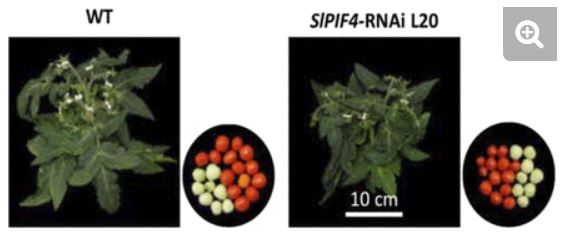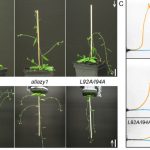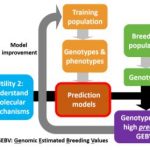PIF4 plays a conserved role in Solanum lycopersicum
Scott Hayes, [email protected]
The adoption of Arabidopsis thaliana as a model plant in the early 1980s led to a revolution in plant molecular genetics. Its diminutive size, rapid generation time and small genome made Arabidopsis a fantastic tool, allowing us to build a complex picture of the genetic architecture underlying plant development (Koornneef and Meinke, 2010). Light and temperature are important modulators of plant growth, and in Arabidopsis these environmental cues are integrated through the PHYTOCHROME INTERACTING FACTOR (PIF) family of transcription factors. If we wish to convert our knowledge of Arabidopsis development into enhanced food security, it is essential that we investigate the conservation of these pathways in nutritionally relevant crops. In this issue of Plant Physiology, Daniele Rosado and colleagues from the Magdalena Rossi lab at the University of São Paulo take a step towards doing so with a thorough characterisation of PIF4 in tomato (Solanum lycopersicum). https://doi.org/10.1104/pp.19.00833
The Rossi group had previously used phylogenetics and transcriptional profiling to identify potential PIFs in tomato (Rosado et al., 2016). They designated one tomato gene SlPIF4 because it falls into the same clade as AtPIF4 and AtPIF5, and shows a similar diurnal expression pattern (Rosado et al., 2016). AtPIF4 is particularly important in the control of plant architecture in response to warm temperatures (Koini et al., 2009). In the current study, Rosado et al. set out to study the function of SlPIF4. They began by producing several RNAi knock-down lines and confirmed that these lines show a reduced level of SlPIF4 expression.
 In their paper, the group demonstrates that tomato seedlings grown at 30°C have longer hypocotyls than those grown at 25°C, but that this does not occur in plants with reduced levels of SlPIF4. The group also found a SlPIF4-dependent upregulation of the likely auxin biosynthesis gene SlYUC8 at warm temperatures, suggesting that warm temperature signal transduction is likely conserved between the two species. Even in the absence of warm temperature treatments, adult SlPIF4-RNAi lines generally had a compact structure (Figure 1). This architectural change may be due to the reduced levels of auxin in these plants, particularly in the leaves.
In their paper, the group demonstrates that tomato seedlings grown at 30°C have longer hypocotyls than those grown at 25°C, but that this does not occur in plants with reduced levels of SlPIF4. The group also found a SlPIF4-dependent upregulation of the likely auxin biosynthesis gene SlYUC8 at warm temperatures, suggesting that warm temperature signal transduction is likely conserved between the two species. Even in the absence of warm temperature treatments, adult SlPIF4-RNAi lines generally had a compact structure (Figure 1). This architectural change may be due to the reduced levels of auxin in these plants, particularly in the leaves.
Previous studies have demonstrated roles for SlPIF1a and SlPIF3 in tomato fruit ripening (Llorente et al., 2016; Gramegna et al., 2019). Rosado et al. noticed that their SlPIF4 knock-down lines produced deep-red fruit, which indicates that SlPIF4 likely suppresses tomato pigment production (Figure 1). The group show that SlPIF4-RNAi tomatoes ripen faster even when detached from the plant, consistent with local SlPIF4 function in the fruit. In addition, the group report that suppression of SlPIF4 has strong effects on starch accumulation within the fruit.
Faster ripening tomatoes may be a desirable trait for agriculture, but it should be noted that there were also negative effects on fruit number in the SlPIF4-RNAi lines. Although these plants showed no delay in flowering time, they produced fewer flowers and accordingly, fewer fruit. In Arabidopsis, PIFs promote the transition to reproductive growth by directly upregulating the expression of the flowering inducer FT in the leaves (especially in the presence of shade or warm temperatures (Kumar et al., 2012; Galvāo et al., 2019)). Rosado et al. demonstrate that their SlPIF4 knock-down lines have reduced FT in the leaves, and an associated misregulation of floral transition genes in the shoot apex.
Finally, the group turned their attention to one of the final aspects of plant development, senescence. They observed that SlPIF4-RNAi plants exhibit delayed senescence, which is confirmed by the observation of reduced senescence marker gene expression. This is in accordance with the key role that AtPIF4 and AtPIF5 play in the promotion of senescence in Arabidopsis (Sakuraba et al., 2014) and confirms a well-conserved role of PIF4 function right across the tomato life-cycle.
More studies like that of Rosado et al. will be needed in the coming years for us to understand how the plants we eat really grow. Their paper highlights the extraordinary translatable value of research performed in Arabidopsis, whilst also demonstrating its limitations. Many of the harvestable organs of crops differ greatly from the organs of Arabidopsis, necessitating direct study of agriculturally relevant species. The current study also demonstrates the potential value of spatially or temporally specific modulation of gene function in genetically modified crops. For example, reducing SlPIF4 expression specifically in tomato fruit could conceivably result in more appetising tomatoes without a reduction in the number of tomatoes per plant. The current wave of studies in translatable research is set to open up exciting opportunities towards achieving food security in the years to come.
References
Galvāo VC, Fiorucci AS, Trevisan M, Franco-Zorrilla JM, Goyal A, Schmid-Siegert E, Solano R, Fankhauser C (2019) PIF transcription factors link a neighbor threat cue to accelerated reproduction in Arabidopsis. Nat Commun 10: 1–14
Gramegna G, Rosado D, Sánchez Carranza AP, Cruz AB, Simon-Moya M, Llorente B, Rodríguez-Concepcíon M, Freschi L, Rossi M (2019) PHYTOCHROME-INTERACTING FACTOR 3 mediates light-dependent induction of tocopherol biosynthesis during tomato fruit ripening. Plant Cell Environ 42: 1328–1339
Koini M, Alvey L, Allen T, Tilley C, Harberd N, Whitelam G, Franklin K (2009) High Temperature-Mediated Adaptations in Plant Architecture Require the bHLH Transcription Factor PIF4. Curr Biol 19: 408–413
Koornneef M, Meinke D (2010) The development of Arabidopsis as a model plant. Plant J 61: 909–921
Kumar S, Lucyshyn D, Jaeger K, Alós E, Alvey L, Harberd N, Wigge P (2012) Transcription factor PIF4 controls the thermosensory activation of flowering. Nature 484: 242–5
Llorente B, D’Andrea L, Ruiz-Sola MA, Botterweg E, Pulido P, Andilla J, Loza-Alvarez P, Rodriguez-Concepcion M (2016) Tomato fruit carotenoid biosynthesis is adjusted to actual ripening progression by a light-dependent mechanism. Plant J 85: 107–119
Rosado D, Gramegna G, Cruz A, Lira BS, Freschi L, De Setta N, Rossi M (2016) Phytochrome Interacting Factors (PIFs) in Solanum lycopersicum: Diversity, evolutionary history and expression profiling during different developmental processes. PLoS One 11: 1–21
Sakuraba Y, Jeong J, Kang M, Kim J, Paek N, Choi G (2014) Phytochrome-interacting transcription factors PIF4 and PIF5 induce leaf senescence in Arabidopsis. Nat Commun 5: 1–13




